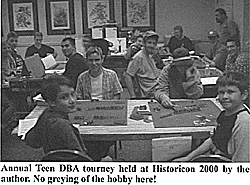 Rules typically get reviewed when they are first published, maybe again if a major up-date is made. In some sense, that does a disservice as the review can rely on but one, or at best a couple of playtests.
Rules typically get reviewed when they are first published, maybe again if a major up-date is made. In some sense, that does a disservice as the review can rely on but one, or at best a couple of playtests.
At right: DBA Teen Tournament at Historicon 2000. No greying of the hobby!
Much of a review deals with the format, the style, and the perception of the rules. Sometimes reviewers do not really catch on to the significance of new rules, especially if there is a paradigm change. Consider The Courier’s review of Dungeons and Dragons http://www-personal.umich.edu/~beattie/timeline/1972-1979/dd.gif
I think this scenario was true for DBA when it first came out in 1990. Some reviewers just did not catch on to what it was about. Practical Wargames, for example, did not seem to even notice it, carrying no review whatsoever that I could find. With a bit more coverage was Miniature Wargames with a 1/6th of a page review by Ian Dickie. He dismissed DBA with, “… the rules are meant to be light relief and with a modicum of study they could provide just that.” He also made the snide comment about the use of the rules after an initial game with his club. “ That was a few weeks ago and no one has suggested getting them (the rules) out again.”
On the other hand, Pete Duckworth of Wargames Illustrated had caught on to the potential, calling it “… radically different in style and effect…” and further notes, “ In DBA, Phil Barker has come up with probably the most original thinking that wargaming has yet seen…” He devotes half a page to his coverage, concluding with, “All ancients players should give them a try-out to blow away the cobwebs.”
This time The Courier was right on with its review. Rod Burr, later to become winner of many USA DBA championships, spent two pages examining the rules, observing that “DBA is a completely different beast.” He notes that “The only thing in common with the classic ancients rules are suggested but not required base size.” He concludes, “Overall the DBA rules are an excellent alternative to the larger slower playing ancients games such as WRG 7th and Tactica.” He certainly saw the paradigm shift in these rules.
Society of Ancients (SOA) reviewers presented a different out look. What rules had Matthew Bennet been playing to lead him to say, in The Slingshot’s page and a third review, “There is nothing especially new about any aspect of the game:…”? In a second review in that journal, Paul Szuscikiewicz does not see the paradigm shift. He says they are like the Bath Rules and have a feature in common with TSR’s Classic Warfare. He says, “ (he) would not consider risking championship points on such a dicey set. Nor do they provide a slow enough game for my tastes.” (His colleague, by the way, had written, “The speed of the game is the most attractive thing for me…”)
Most of Szuscikiewic’s page and a quarter review was devoted to recounting a game he and a friend played. Very little factual information about the rules in either of the Slingshot reviews, nor any notice of the potential for change it offered. Also much lack of imagination as Bennet devoted much space to being very critical of how many figures per base Phil had suggested. I wanted to yell, “hey, just use as many as you want, it has no effect on the game!” One of Szuscikiewic’s complaints focused on the inability of players to provide pre-battle oration.
So, five early reviews and only two caught on the significance of the little rules booklet. An interesting comparison, too, among them in terms of content. The Burr and the Duckworth pieces give an excellent overview of the actual content of the rules, i.e., how to play. Duckworth goes so far as to compliment the authors on clarity of presentation while Burr gives a negative mention to the “rules writing style for which WRG is so well known.” Dickie’s review is too short to give any space to the presentation. Both SOA writers refer to some aspect of the literary aspect. Szuscikiewic chides the authors in two paragraphs for not knowing how to use a semi-colon. Bennet comments about a lack of diagrams and the need to “re-read a paragraph to discern its sense.”
In all fairness, Phil Barker has come to realize the need for better clarity. He wrote in an internet message in the first week of January, 2001, “The original concept of DBA was that it should be simple enough for a 7 year old to memorise. This worked well in the UK, but apparently not in the US, which likes to search the fine print for unlikely interpretations. V2.0 has accordingly much closer definitions to hopefully satisfy Bob Beattie if not Florida Democrat lawyers.” Strange, isn’t it that the UK reviewers commented on the lack of easily readable text.
That is it for the critics, but what did the wargaming public think of this new contribution.
More DBA: 10 Years
-
Introduction
My Personal Voyage into DBA
DBA in the Wargame World
World Wide Acceptance of DBA in the 90s
DBA and the Internet
Preview of DBA 2.0
Big Battle DBA (BBDBA)
Conclusion
DBA: Review from Courier Vol IX No. 4
Back to Table of Contents -- Courier #81
To Courier List of Issues
To MagWeb Master Magazine List
© Copyright 2001 by The Courier Publishing Company.
This article appears in MagWeb (Magazine Web) on the Internet World Wide Web.
Other military history articles and gaming articles are available at http://www.magweb.com